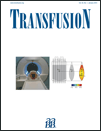Donor safety in triple plateletpheresis: results from the German and Austrian Plateletpheresis Study Group multicenter trial
The study was financed by grants from Baxter Deutschland GmbH, Unterschleißheim, Germany; Fresenius Transfusions GmbH, Friedberg, Germany; Gambro BCT, Zaventem, Belgium; and Haemonetics Deutschland GmbH, Munich, Germany.
Abstract
BACKGROUND: The objective was to investigate potential risks for apheresis donors associated with a triple-plateletpheresis (TP) program.
STUDY DESIGN AND METHODS: Eleven hemapheresis centers randomly assigned 411 repeat donors (ratio, 1:1.2) to either double plateletpheresis (DP; 185 donors) or TP (226 donors) with a platelet (PLT) target content of at least 5.0 × 1011 PLTs/DP and at least 7.5 × 1011 PLTs/TP. The primary endpoint was procedure-related postapheresis PLT count of at least 150 × 109/L (probability, ≥98%). Secondary endpoints were apheresis characteristics and donor adverse reactions.
RESULTS: In 6 of 1133 DPs (0.5%) in 4 of 185 donors (2.2%) and in 20 of 1020 TPs (2.0%) in 14 of 226 donors (6.2%), postapheresis PLT counts were below 150 × 109/L. There were marginal but significant differences in collection efficiency (DP, 69.2 ± 9.1%; TP, 70.9 ± 9.0%; p ≤ 0.0001) and collection rate (DP, 10.4 × 109 ± 2.3 × 109 PLTs/min; TP, 10.8 × 109 ± 2.3 × 109 PLTs/min; p ≤ 0.005). The PLT yields were 5.9 × 1011 ± 0.8 × 1011 PLTs for DP and 8.3 × 1011 ± 0.9 × 1011 PLT for TP (p ≤ 0.0001) at processing times of 59 ± 13 minutes (DP) versus 80 ± 16 minutes (TP; p ≤ 0.0001). Significant PLT recruitment (1.10 ± 0.14 vs. 1.20 ± 0.23; p < 0.0001) was seen for both DP and TP. DP and TP did not differ with regard to venous access problems (VAPs) without discontinuation (3.8% for both), but DP induced fewer VAPs with discontinuation (1.1% vs. 3.0%; p < 0.01). Mild citrate toxicity (1.7% vs. 3.9%; p < 0.01) and circulatory reactions (0.4% vs. 2.2%; p < 0.01) were more often noticed in TP, but caused no increase in discontinuations.
CONCLUSIONS: TP results in an increase in mild donor reactions but does not significantly impair donor safety or product quality.




